Photo

Scientists Say We're Closer to Nuclear Armageddon Than Any Other Point in History
Story by Noor Al-Sibai
Image credit: Mark Stevenson/UIG via Getty / Futurism
Original published by Futurism on January 24, 2023.
Black Pilled
The scientist-activists who run the Doomsday Clock have once again ticked it forward, bringing humanity's estimated chances of its own nuclear annihilation closer than ever.
A statement published by the Bulletin of the Atomic Scientists, the group behind the Doomsday Clock, cited Russia's invasion of Ukraine and the potential for a "hot war" between NATO and Russia as its reasoning for moving the clock a mere 90 seconds to midnight.
Founded in 1945 by Albert Einstein and the scientists who would have been his colleagues had the US granted him security clearance to work on the atomic bomb-building Manhattan Project, the BAS has every year since 1947 warned of the preceding annum's biggest risks to humanity — and this year, those risks are all about Russia.
"Russia’s thinly veiled threats to use nuclear weapons remind the world that escalation of the conflict — by accident, intention, or miscalculation — is a terrible risk," the statement reads. "The possibility that the conflict could spin out of anyone’s control remains high."
Hot War
While not mentioned in the statement, the country formerly known as the Soviet Union has some pretty jarring past precedents to take into consideration: the 1983 "false alarm" incident in which USSR radar picked up and subsequently alerted officials about phony readings from the West that were initially interpreted as warhead-carrying spy planes coming out of the US.
The protocol, which wasn't followed, would have been to strike back. If Stanislav Petrov, the Soviet Air Defense officer in charge of the early-warning station located that detected the misinterpreted signals, hadn't trusted his gut when it told him they were false alarms, nuclear war would almost certainly have broken out.
Back in the present, the concerned scientists note that beyond just the heating up of the new cold war, Russia's Ukrainian aggression has also "undermine[d] global efforts to combat climate change," and its fake news about Ukraine developing bioweapons may indicate that it's doing exactly that.
While "there is no clear pathway for forging a just peace that discourages future aggression under the shadow of nuclear weapons," the BAS urged open engagement with peace talks between NATO and Russia — not just for the sake of heading off war, but for the sake of helping the planet avoid further catastrophe, too.
More on nukes: New Study Shows Where You Should Hide To Survive A Nuclear Attack
#futurism#doomsday clock#nuclear war#russia#ukraine#armageddon#nukes#albert einstein#atomic bomb#atomic warfare#manhattan project#NATO#ukrainian invasion#stanislav petrov#back in the ussr#latest#tech
1 note
·
View note
Photo
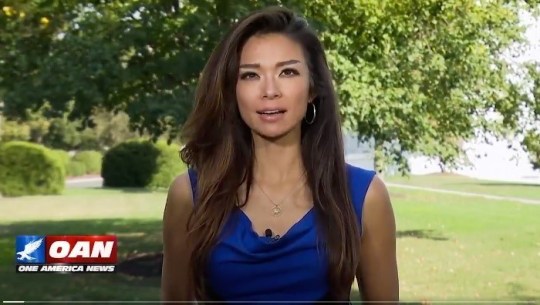
Pro-Trump OAN pushes wild conspiracy theory that novel coronavirus was created in a North Carolina lab
Published by Media Matters for American on 3/18/2020.
OAN’s chief White House correspondent endorsed a conspiracy theorist who has said Anthony Fauci funded creation of the coronavirus to destroy the Trump economy.
WRITTEN BY JOHN WHITEHOUSE
RESEARCH CONTRIBUTIONS FROM NOOR AL-SIBAI
On March 14 and 15, pro-Trump cable news network OAN aired a coronavirus special called Exposing China's Coronavirus: The Fears, The Lies and The Unknown. During that program, the network’s chief White House correspondent, Chanel Rion, suggested that the novel coronavirus responsible for the current pandemic may have originated in a North Carolina laboratory.
As support, Rion cited Greg Rubini, whom she described in the special as “a citizen investigator and monitored source amongst a certain set in the D.C. intelligence community.”
There is no evidence that Rubini is a “monitored source” for anyone but Rion. He has pushed wild “deep state” conspiracy theories on Twitter, where he has over 100,000 followers.
Rubini has said that the novel coronavirus “was GENETICALLY ENGINEERED as a Bio-Weapon at the Univ. of North Carolina BSL-3 Lab.” He has also said that it was spread from North Carolina to China, Italy, and elsewhere in the United States by the “Deep State” in a plot “to destroy the Trump economy.” In addition, Rubini suggested that Dr. Anthony Fauci, the well-respected head of the National Institute of Allergy and Infectious Diseases, personally funded the production of the virus, even calling him “Little Tony Fauci.”
OAN coronavirus special featured former top Trump officials
The OAN special, which was promoted on Twitter, YouTube, and Facebook, began with commentary like what you would see on Fox News, such as calling COVID-19 “Chinese-born” (viruses have neither a race nor a nationality) and saying that President Donald Trump had taken strong steps to protect America (he downplayed the threat and reacted extraordinarily poorly and slowly).
The first hints of just how deranged that this special would be showed up in the second segment, which was, amazingly, geared toward attacking South Korean President Moon Jae-in. The segment featured a panel including two former top Trump officials: acting Attorney General Matthew Whitaker and former National Security Council chief of staff Fred Fleitz. The panel also included columnist and frequent Fox guest Gordon Chang and former South Korean official Cho Tae-yong. The panelists attacked Moon’s response to the coronavirus epidemic, with Fleitz even saying that the South Korean president showed “incompetence and naivete” because he has downplayed threats coming from China and North Korea. (South Korea’s response to coronavirus has been widely considered a success, thanks largely to its aggressive testing regime, an area in which the U.S. has failed.)
In the next segment, after a discussion of outsourcing production of drugs and medical supplies, Chang said that China “owns” the World Health Organization.
But it was in the final segment that OAN's coronavirus special went completely off the rails.
Conspiracy theory: A bioweapon created in North Carolina to undermine the Trump economy
Rion cited experts who had expressed doubt that the virus originated in a seafood market in the city of Wuhan, China, and then she took that doubt to mean that it must have originated elsewhere. Saying that there are some “interesting clues” in the United States, Rion pointed to a laboratory in North Carolina:
Rion is pushing a debunked conspiracy theory. It circulated last week in Britain’s Express tabloid, after which experts repeatedly debunked it and the Express even ran a correction. The Express’ source was a guest on conspiracy theorist Alex Jones’ show, Francis Boyle, who alleged that the coronavirus was a bioweapon created in Wuhan.
While Boyle, Steve Bannon, Sen. Tom Cotton (R-AR), and others have pushed a conspiracy theory that the virus was a bioweapon that originated in a facility in Wuhan, Rion went in a slightly different direction. She cited a 2015 study from the National Institutes of Health, titled “SARS-like cluster of circulating bat coronavirus pose threat for human emergence,” and used its links to the University of North Carolina to suggest that the novel coronavirus was created there.
After Rion mentioned the study, she named authors who purportedly have links to Wuhan. While there are no audio issues elsewhere in the special, on both the Saturday and Sunday airings of this special, Rion’s voice is muted when saying the names, though the authors list for the 2015 study does include the names of two scientists, Zheng-Li Shi and Xing-Ye Ge, who have worked at the Wuhan Institute of Virology. (Conspiracy theories about these scientists go back to at least January 26.)
On OAN, Rion also cited Greg Rubini as an expert. Rubini had tweeted the conspiracy theory at Rion the day before the special aired, in a thread still pinned to his Twitter profile at the time this piece was published. Before that, Rubini had also previously tweeted that the virus was created in a North Carolina lab. While never explicitly citing this study, on February 25, Rubini tweeted at former Italian Deputy Prime Minister Matteo Salvini: “this VIRUS is a BIO-WEAPON - genetically engineered in a North Carolina Lab, and brought to Wuhan by a Chinese scientist. … I have the documents. be advised.”
While Rion cited Rubini’s conspiracy theory that the virus was created in North Carolina, she concluded by implying that Chinese scientists, after purportedly helping to create the virus in North Carolina in 2015, then released it from a laboratory in Wuhan near the end of 2019. This is more in line with the Bannon and Cotton conspiracy theory than with Rubini’s even more deranged notion.
Rubini posits that the “deep state” sent the virus from North Carolina to China, Italy, and then back to the United States. He is also convinced that Anthony Fauci personally funded its creation.
Rubini has repeatedly accused Fauci of being behind the pandemic as a tool of the “deep state.” Along those lines, he has also pointed the finger at former CIA Director John Brennan, former Director of National Intelligence James Clapper, and former National Security Agency Director Michael Hayden.
Rubini also recently called for Trump to immediately declare martial law for two months. Additionally, he has claimed that communists and Muslims have “infiltrated” the Pentagon and that the novel coronavirus outbreak is a “cover” for a “Nazi coup” in Europe.
Rion has repeatedly interacted with Rubini on Twitter.
Before being hired by OAN and eventually being appointed as its chief White House correspondent, Rion was a Seth Rich conspiracy theorist.
#oan#oann#one america news#one america news network#chanel rion#covid-19#coronavir#conspiracy theory#covid conspiracy#coronavirus conspiracy
1 note
·
View note
Photo

Right-wing media push QAnon-linked hoax claiming a kid was jumped for wearing a MAGA hat
Published by Media Matters on December 18, 2019.
A white QAnon-supporting parent in Florida claimed in late November that their son was jumped by "8 black kids" for wearing a Trump hat. In December, the account posted a video that was allegedly taken of the kids beating the child up on a school bus — and right-wing news outlets and pundits ran with it. But the school system says the attack was unrelated to politics.
On November 21, the @AmericanDiaries Twitter account, a supporter of the QAnon conspiracy theory, shared a photo of a child with a blanket over his head, claiming the boy is their son and that he’d been attacked because of his beliefs.
“I am sitting in the hospital with my 14 year old kid because he was just jumped by 8 black kids on the school bus,” the poster wrote. “I guess that's what happens when a kid wears a #Trump hat to school. And who's the violent ones again? Earlier today they poured milk all over his head.”

Three weeks later, the same account shared a graphic video described as portraying the incident, asking people to retweet it “to have these two girls and 3 boys held accountable” (a departure from the initial claim that “8 black kids” assaulted the child).
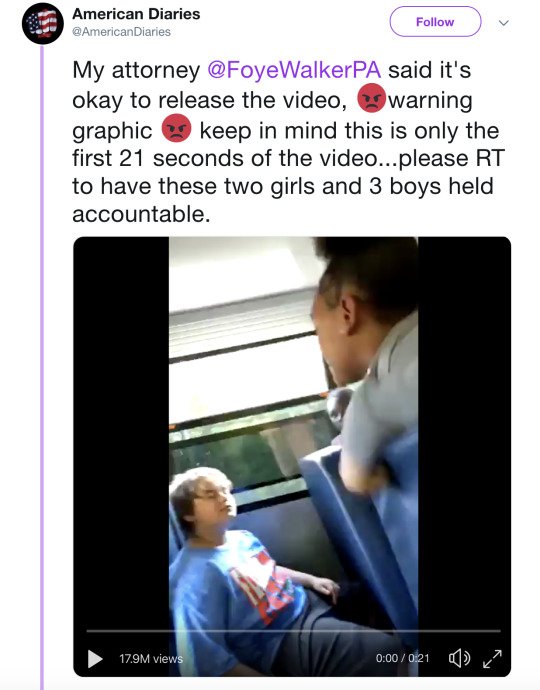
The school district has denied the contention that the fight was spurred by a Trump hat.
“There was no evidence found during the investigation that indicated the student was wearing any of this apparel at the time of the altercation,” Hamilton County Superintendent Rex L. Mitchell said in a statement, “or that his wearing of such apparel on a prior occasion motivated the incident.” Reporting on this statement, Snopes has also debunked the claim.
The @AmericanDiaries account’s video and story reached right-wing pundits including Turning Point USA’s Charlie Kirk and the president’s attorney Rudy Giuliani. Both used the initial claim that the boy was beat up by Black classmates for wearing a Trump hat without noting the school’s denial of that story.
Soon after, the claim reached right-wing and right-leaning sites including Fox News, Breitbart, the New York Post and Daily Mail. Local news sites owned by Sinclair Broadcast Group also published the account, though it was later taken down.
Though Fox, the Daily Mail, and the New York Post did note the school’s denial of the parent’s sequence of events, they all still included mentions of the Trump hat in their headlines. The image that appears with the Fox article about the incident on social media and in search results is still a “Make America Great Again” hat.

And the story has continued to spread in right-wing circles.
Pro-Trump comedian Terrence K. Williams, a pundit who has spread hoax claims before, posted the video of the bus attack and wrote, “Why is the mainstream media not covering this ? If some white kids beat up someone for liking Obama this would be National News.”

Former Republican presidential candidate-turned-Trump-surrogate Herman Cain also posted about the video, linking to an article from the conservative Western Journal website that noted in its headline that the sheriff’s office did not consider the attack a hate crime.
“In other words,” Cain wrote, “the only purpose of ‘hate crime’ laws is to make it a bigger crime to beat up people liberals like.”

As Media Matters’ Alex Kaplan noted when the video and claim first went viral, the account that posted it is a clear supporter of the QAnon conspiracy theory. QAnon conspiracy theorists believe there is a pro-Trump government operative who goes by the code name “Q” who will save America from a pedophilic global cabal. It has been linked to the “Pizzagate” conspiracy theory that inspired a North Carolina man to open fire in a Washington, DC pizza restaurant.
The @AmericanDiaries account has posted or retweeted QAnon content on multiple recent occasions.
On November 23, the account posted a meme with the phrase “Where We Go One, We Go All” and its associated hashtag. As the Washington Post reported in August, the phrase “may seem fairly anodyne, a clunky but earnest way of capturing the sentiment behind ‘e pluribus unum’” but is in fact “the main rallying cry of QAnon conspiracy theorists.”
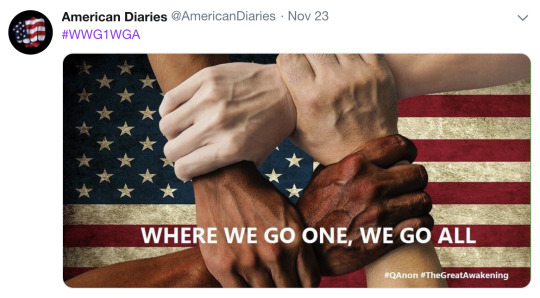
On December 9, @AmericanDiaries also retweeted a QAnon meme that called on supporters to “go to Washington D.C. & demand the military arrest these globalist traitors.”
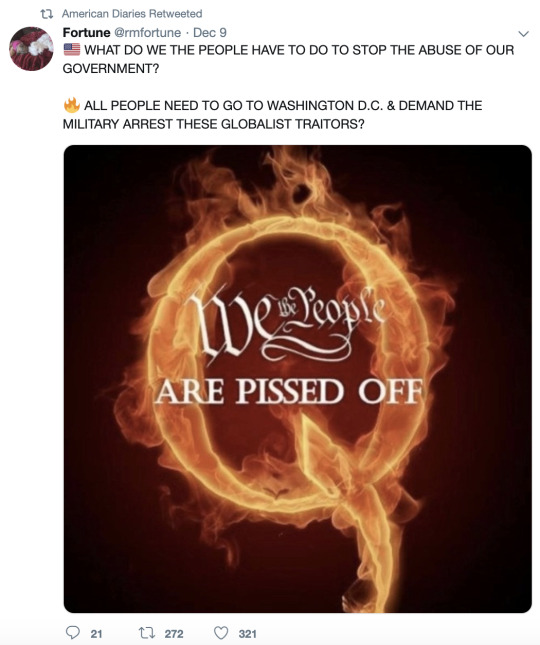
0 notes
Photo

Taylor Swift ‘Embraces’ LGBTQ People While Ignoring Her Nazi Fanboys
Published by Wear Your Voice Magazine on June 18, 2019.
She may be trying to become the next queen of the gays, but Swift will remain an erstwhile “Aryan goddess” until she forcefully proves otherwise.
Move over, Gaga — Taylor Swift is attempting a coup as she auditions for a new role as self-appointed queen of the gays, replete with a racist mercenary fanbase.
On June 14, halfway through the murkily-originated “WorldPride” month and two weeks shy of the 50th anniversary of the Stonewall Inn riots, Swift took to the stage of that famed gay NYC establishment in a surprise performance joined by “Modern Family” actor Jesse Tyler Ferguson.
Swift’s Stonewall stunt, which occurred just one day after she released a single ostensibly aimed at homophobes titled “You Need to Calm Down” and two before she released the LGBTQ celeb-studded video for the song was unsurprisingly heralded as a phoned-in PR move from an almost-definitely-straight celebrity.
“I wonder how many queer people couldn’t visit [S]tonewall today so Taylor Swift could do her little publicity stunt,” one Twitter user mused on the night of the pop star’s surprise New York performance.
“Taylor Swift threw the first bachelorette party at Stonewall,” Crooked Media’s Louis Virtel joked, making a reference to the “threw the first brick at Stonewall” meme.
Intentions and public opinion aside, it’s worth noting that Swift has indeed become increasingly political over the years. She’s now vocal about her support for LGBTQ rights and at the end of the “You Need to Calm Down” video included a call for fans to sign her petition geared towards the passage of the identity-based Equality Act.
In the 2018 midterms encouraged her fans to vote for Democrats, noting that then-Tennessee Senate candidate Marsha Blackburn’s voting record on queer and trans rights “appalls and terrifies” her. In her statement, she also spoke out against “systemic racism.”
“In the past I’ve been reluctant to publicly voice my political opinions,” Swift wrote in a lengthy Instagram caption, “but due to several events in my life and in the world in the past two years, I feel very differently about that now.”
The country-pop songstress remains “reluctant,” it seems, to overtly denounce the neo-Nazis and white supremacists who consider her an “Aryan goddess” — even while purportedly promoting the rights of fascist-targeted groups.
After Swift endorsed Blackburn’s opponent and the Democratic Party, outlets like Vanity Fair and the Washington Post declared it an end to the “meme” that the artist enjoys the support of violent racists.
“[N]ow the lark is over,” VF’s Kenzie Bryant wrote, noting that the “Aryan goddess Taylor Swift” meme was orchestrated as a “joke” by the neo-Nazi Daily Stormer website and its fans on 4chan.
Bryant went on to quote Andrew Anglin, the site’s M.I.A. founder, who insisted that he and his ilk created the meme to get the Stormer “blacklisted.” Anglin, she wrote, “firmly restated that the ‘Aryan goddess’ thing was a joke,” and that his website hosts “ironic Nazism disguised as real Nazism disguised as ironic Nazism” — and anyway, Nazis rejected Swift after she endorsed Democrats, suggesting the move was tantamount to a denunciation.
Setting aside that dismissing “ironic Nazism” online has resulted in a lack of preparation for the real-world massacres and murders committed by fans of people like Anglin, the argument that Swift essentially denounced her fascist fanboys is based in a major and obvious fallacy. In an era where synagogues, mosques, Black churches, and gay clubs have all been attacked, when neo-Nazis march brazenly through towns and openly organize online, the only way to denounce white supremacists is to name them specifically.
It’s not unheard of for artists to call out their bigoted fans. After white supremacists marched with gear featuring the “Punisher skull” at the deadly “Unite the Right” rally in Charlottesville, VA in 2017, the comic’s writer and co-creator Gerry Conway told Inverse that he was disgusted by how the symbol had been co-opted by the alt-right.
“They’re despicable human beings, and [‘The Punisher’] Frank Castle would have all of them in his crosshairs,” Conway said in December 2017. “The fact that white nationalists and Nazis embrace it is a tragic misunderstanding. It’s a misappropriation of the character and a blatant disregarding of reality. They literally do not know what they are fucking talking about.”
Jon Bernthal, the actor who plays Castle in Netflix’s adaptation of the popular vigilante comic series, didn’t parse words when it came to neo-Nazi “Punisher” fans.
“Fuck them,” he told Esquire in early 2018.
The current “Punisher” showrunners, it seems, took Bernthal and Conway’s sentiments to heart, making the villains in the latest installment religious Nazis and members of the alt-right.
Although still championed by police and military, the people behind “The Punisher” showed exactly how to draw an ideological line between themselves and the racists who would make the character into a fascist symbol — a lesson others, like Swift, could learn from.
Regardless of whether or not Swift is queer, how many LGBTQ friends she has and includes in her music videos, how many GLAAD donations she inspires and how many performances she does at famous gay clubs, the artist’s avowed support for queer and trans people and people of color rings incredibly hollow after years of silence on her neo-Nazi fanbase. She may be trying to become the next queen of the gays, but Swift will remain an erstwhile “Aryan goddess” until she forcefully proves otherwise.
#taylor swift#neo-nazis#you need to calm down#wear your voice#wear your voice magazine#noor al-sibai#editorial#latest#gaylor
0 notes
Photo

Echoes of Flint in ‘Chernobyl’
Published by Truthdig on June 14, 2019.
The best analog for the Chernobyl nuclear disaster may be the years-long public health crisis that began on the watch of Trump’s predecessor.
On May 30, toward the end of its five-week run on HBO, author Stephen King tweeted that the mini-series “Chernobyl” is impossible to watch without considering our feckless and incompetent president. “Like those in charge of the doomed Russian reactor,” King wrote, “[Donald Trump] is a man of mediocre intelligence in charge of great power—economic, global—that he does not understand.”
As television critics have observed, “Chernobyl” all but invites comparisons between Soviet Russia and late-capitalist America. It’s easy to watch the show’s craven apparatchiks and be reminded of this administration’s egregious mishandling of Puerto Rico in the wake of Hurricane Maria. Still, the best analog for the Chernobyl nuclear disaster may be the years-long public health crisis that began on the watch of Trump’s predecessor.
“When the people of Flint, Michigan, complained that their tap water smelled bad and made children sick,” The Guardian’s Anna Clark wrote in July 2018, “it took officials 18 months to accept there was a problem.”
In 2014, Michigan state officials told Flint residents that although their water was disconcertingly odorous and discolored, tasted of copper and appeared to be giving people skin rashes, it was perfectly safe to drink. This insistence from government officials that there is no cause for alarm is echoed in “Chernobyl,” when, in the immediate aftermath of the meltdown, plant higher-ups and Soviet officials inform employees and the people of nearby Pripyat that its nuclear explosion is merely a fire. The town and its environs are eventually evacuated, but not before thousands are exposed to deadly radiation. At virtually every turn, the government’s efforts to contain what Zharkov (Donald Sumpter) calls “the spread of misinformation” end up exacerbating the crisis.
The similarities between these two incidents don’t end at institutional inaction, unfortunately. In Flint, as in Chernobyl, the state acknowledged that warning signs were ignored after the worst-case scenario had come to pass. And in both disasters, officials only took responsibility for their negligence after the knowledge of what had happened spread outside the affected regions.
Perhaps the most haunting parallel between the Chernobyl and Flint debacles, however, is that their true perpetrators have largely gone unpunished. While we learn in the show’s epilogue that a trio of Russian scientists were sentenced to 10 years of hard labor for their crimes, the Soviet bureaucracy that enabled them escapes indictment. And just this week, prosecutors dropped criminal charges against eight officials in the Flint water scandal, pledging to begin their investigation anew. It appears that one of the warnings of Chernobyl—that the powerful are rarely held accountable in a major disaster—has largely gone unheeded.
“Chernobyl” is not without its historical inaccuracies. “Resignation was the defining condition of Soviet life,” writes Russian-American journalist and author Masha Gessen in a recent essay for The New Yorker. “But resignation is a depressing and untelegenic spectacle. So the creators of ‘Chernobyl’ imagine confrontation where confrontation was unthinkable—and, in doing so, they cross the line from conjuring a fiction to creating a lie.”
Whatever its failings, “Chernobyl” is nonetheless a powerful cautionary tale about what happens when bureaucrats put public perception over the lives of the people they’re meant to serve. In their efforts to keep the truth from spreading—or to reshape it entirely—Soviet officials revealed the lengths to which they’d go to protect themselves. But as the series reminds us, and as the Flint crisis illustrated before it, “The truth doesn’t care about our needs or wants. It doesn’t care about our governments” or “their ideologies.”
#chernobyl#flint#stephen king#trump#obama#ussr#neoliberalism#noor al-sibai#truthdig#editorial#latest
0 notes
Photo

In ‘Booksmart,’ The Pussy Hats Come Home to Roost
Published by Wear Your Voice Magazine on June 11, 2019.
If Booksmart’s creators had left the characters of color as tokens, it would have been one thing—but those characters’ trajectories by the end of the film turns the filmmakers’ carelessness into cruelty.
If you read reviews in Jezebel, The A.V. Club, or Screen Rant, you’d think Booksmart, actress Olivia Wilde’s directorial debut, was a heartfelt coming-of-age story, an entertaining and empowering romp through a single day in the lives of a pair of teenage best friends replete with a modern sense of diversity. “Booksmart is the first truly evolved high school movie,” Glamour uproariously declared—though that evolution, upon closer inspection, only takes place for white viewers.
The film centers on a pair of Women’s March-ing best friends: the domineering Molly (played by Beanie Feldstein, the younger sister of fellow teen comedy alum, Jonah Hill) and the queer and quiet Amy, played by Beautiful Boy actress Kaitlyn Dever. Their pussy hat politics become clear via a “Warren 2020” bumper sticker and an enamel pin-clad denim coat. On its surface, Booksmart is a fun inversion of the classic “one last party” teen movie trope. Molly and Amy, both as bookish as they are strident and both attending Ivy League schools, learn after a ban on discussions of college admissions that their hard-partying classmates are set to attend universities or go on adventures just as prestigious as theirs. And thus the chubby/lesbian duo sets off to get four years of partying done in one night before they graduate high school—and in their quest, encounter and engage with a ragtag ensemble of classmates from their suburban Los Angeles high school who they’re now seeing with fresh eyes.
The portrayals of Amy and Molly fall within the tried-and-true 30 Rock and Parks and Rec formula by taking two stereotypical third-wave feminists and humanizing them, showing their weaknesses and ultimately portraying them evolving past their one-dimensional personas into nuanced, fleshed-out heroines. It’s too bad Wilde and the team behind Booksmart didn’t afford that same sensitivity to the rest of the cast. Of all the primary supporting characters of color—student government VP and jock-turned-love-interest Nick (played by Cuba Gooding Jr.’s son, Mason Gooding), Jessica Williams’ fantastic turn as the cool teacher, Ms. Fine, and Theo, a stoner-coded Latinx skater who openly pines for Williams’ character played by Eduardo Franco—only Ms. Fine never gets anything close to a thought-provoking character arc. Rather than going the route of Broad City, which attempted (and on multiple occasions failed) to incorporate sensitive and realistic characters of color that complicated rather than complimented the show’s stars, Booksmart takes after Girls by paying lip service to “diversity” via the desires of the white women with whom the audience is meant to identify.
In this film, as with Lena Dunham’s would-be magnum opus, people of color are shown for two reasons: to make the film seem more within terms of “diverse” casting in theory and to uncritically extend the storylines of the white women main characters in practice.
Take, for instance, Booksmart’s usage of Malala Yousafzai. When arguing about whether or not to go to Nick’s epic high school rager; Molly invokes the name “Malala,” an apparent get-out-of-jail-free card from a pact she has with Amy so they can attend the soirée being thrown by her oh-so-surprising crush. After arriving at said party, Amy invokes “Malala” right back, causing a massive fight that leads her to a bathroom where she has her first sexual encounter
The Malala plot device is, ironically, one of the most blatant representations of white feminist racism in recent media. White women love to put Black women and non-Black women of color like Beyoncé, Frida Kahlo, and Oprah on pedestals, going so far as to emblazon their likenesses on mugs, votive candles, t-shirts, tote bags and Women’s March signs.
As many brilliant Black women have written, white women are all too happy to “celebrate” (read: commodify) celebrities like Beyoncé and Yousafzai—but when it comes to including them in real, meaningful ways in their social circles, their activist scenes, their creative endeavors and their films and TV shows, they still can’t get it right. If Booksmart’s creators had left the characters of color as tokens, it would have been one thing—but those characters’ trajectories by the end of the film turns the filmmakers’ carelessness into cruelty.
Ms. Fine, as the girls’ naughty voice of reason, not only encourages them to party as hard as they want so they don’t end up going too hard in their 20’s like she did—she also hooks up with Theo (after confirming that he’d been held back a few grades, thus making him 20 years old). Meanwhile, after flirting heavily with Molly over a game of beer pong and appearing to almost make her “forbidden” desire for the jock-party boy come true, Nick tells our heroine to stay where she is—and is next seen making out with Ryan, Amy’s masculine skater-girl crush who (gotcha!) apparently isn’t gay after all. It’s a tidy way to lead both main characters to the people they end up with, and the differences of those two characters—one Black, one gender nonconforming—are summarily ignored after serving their purposes. Molly’s eventual main squeeze turns out to be Jared, a rich white tryhard who rents out a yacht and attempts to buy his classmates’ friendship with iPad goodie bags while wearing a heavy gold chain and a sweatshirt that reads “Fairfax,” the name of one of the main thoroughfares in LA’s Compton neighborhood.
Following in the footsteps of British films and television shows, American entertainment has finally figured out that increasingly brown and Black audiences want to see themselves represented on screen. And as with their British counterparts, movies like Booksmart forego nuanced portrayals of race relations in American schools and instead try to level the playing field by leaving conversations about race out entirely. As a result, they put forth flattened characters played by otherwise excellent actors.
0 notes
Photo

Robbie Trip put the final nail in body positivity’s coffin with his ‘Chubby Sexy’ music video
Published by Wear Your Voice magazine on May 28, 2019.
In “Chubby Sexy,” Tripp capitalizes on his wife’s “thickness” while using a poor approximation of African-American Vernacular English to deliver heavy-handed fat jokes
Robbie Tripp, dubbed “Curvy Wife Guy” by internet cajolers, is back at it again — and this time, he’s White Boy Rapping about his spouse’s fat ass. On May 24, the man who became a meme for negging his full-figured wife, Sarah Tripp, in public, released his musical ode to her figure in the form of a poolside video for his single “Chubby Sexy.”
youtube
With “Chubby Sexy,” Tripp has managed to outdo his July 2017 Instagram essay about how hard it was for him to like bigger girls, an ostensible love letter to his wife and other plus-size women which managed to entirely miss the point of body positivity by contextualizing a woman’s worth within the confines of men finding her attractive. Before the music even begins, Tripp begins his Big Girl Negging anew, declaring that “chubby is the new sexy” in sans serif text superimposed over a pool one can only presume is what he and his wife bought with their “desert money” after going viral.
“This jam is dedicated to all the curvy queens out there just living your best life, girl you deserve that, you deserve an anthem,” the Curvy Wife Guy boasts, listing off terms like “thick” and “BBW” as the tired descriptors he’s ridding us of in favor of the eponymous “Chubby Sexy” moniker he coined for his partner. As a professional journalist who has worked in politics and feminist criticism, I’ve heard my share of offensive soundbites. And reader, I was shocked — shocked! — when Tripp not only shouted out his wife’s weight three separate times and compared her to both James and the Giant Peach and London’s Big Ben. “She got a waist so big that her belt can’t reach,” he sings while rubbing his wife’s butt, a backhanded boast that sounds like something straight out of a pickup artist playbook. Later, he brags that Sarah’s “cheeks swallow up that bikini like a g-string.”
“She don’t need a man,” Tripp bizarrely and awkwardly raps. “Yeah she chubby-yummy.” Beyond all the poor, strange and inconsistent lyrical choices the Curvy Wife Guy makes (he at one point claims his wife is too curvy for a one piece while she’s seen strutting on camera in one and later says she has “thick thighs like a mermaid”) and the obvious autotune, this song serves as yet another reminder that Robbie Tripp is passing off being a chubby chaser as “feminism.” As Vox’s Rebecca Jennings pointed out in her profile of the Tripps, the couple’s problematic pasts were revealed after the “curvy wife” post went viral nearly two years ago. But Robbie Tripp’s most glaring misdeeds have been out in the open since the phrase “I love this woman and her curvy body” became a meme.
Like Sarah Tripp and the small harem Robbie surrounds himself with in the “Chubby Sexy” video, I too am a big girl — and am in fact bigger than “the curvy wife” herself, who before going internationally viral called herself an “in-betweenie” due to being “between” plus and straight sizes. I am, ostensibly, the type of woman to whom Tripp dedicates his body positive “anthem.” Yet while watching it, I felt more ashamed of my body than I have in months, as I was reminded of all the men who told me they like my “big stomach,” told me they’re into my cellulite, and made me feel like there was something distinct and other about my body in comparison to those of thinner women.
The Curvy Wife Guy is not just a meme, nor is he a traditional chubby chaser. He is an influencer-grifter who managed to monetize the tried-and-true “negging” scheme off of his wife’s slightly-broader-than-average backside.
Since going viral, Tripp has failed to realize why so many people were angry when he framed his love for his wife in the context of his desire, that of his peers and societal beauty standards at large (pun very much intended).
In “Chubby Sexy,” Tripp capitalizes on his wife’s “thickness” while using a poor approximation of African-American Vernacular English to deliver heavy-handed fat jokes. As many other columnists have pointed out, Sarah Tripp is a barely plus-sized, blonde, cisgender white woman who is by no stretch of the imagination far outside the confines of Western beauty standards. But in her husband’s telling, she’s fat enough to be compared to massive structures both fictional and actual.
Body positivity, at its inception, was never about selling soap or clothes or increasing the dating pool for heterosexual men. It was meant to reframe the conception of “acceptable” bodies to include fat people, to help us stop feeling like our bodies are disgusting or perverse just because we are different from the women we see on TV and in fashion spreads. With “Chubby Sexy,” Robbie Tripp heightened those differences by objectifying and fetishizing his wife and the big women they cast — and then had the gall to call it a “celebration.”
#robbie tripp#curvy wife guy#chubby sexy#body positivity#fat positivity#wear your voice#noor al-sibai#features#editorial#sassyredlipstick#chubby chasers#fetishization#latest
0 notes
Photo

Turns out this site profiting off of ‘#TheResistance’ is actually run by man who started a pro-Trump PAC
It was only a matter of time before concrete evidence revealed that Trump supporters had managed to profit off of the resistance to his presidency.
Raw Story was alerted by the parody Twitter account @AltCyberCommand that another user, @z3dster, had revealed in a viral thread that although the now-deleted @Resistance_Feed account appeared to be of similar ilk to others in the so-called "resistance," a simple search for the website's owner reveals a much more insidious web.
https://twitter.com/z3dster/status/946515680500899843
"Fun story," the user's thread began, linking to a screenshot of @Resistance_Feed's account that had over 33,000 followers by the time they deactivated. Though their website, ResistanceFeed.net (which was still up at time of writing) looked relatively normal, a whois searched revealed the owner's email is "[email protected]."
"Americafirstera seems like an odd name choice for a pro Resistance site," the user rightfully noted. That email, they noted, led them to the website AmericaFirstEra.com — a site whose layout and design are almost identical to Resistance Feed's, but on the opposite end of the political spectrum.
https://twitter.com/z3dster/status/946515686481854465
When searching the whois for America First Era, the user found that the website was registered to someone named Michael Maday — a man who registered a pro-Trump political action committee under the America First Era name with the Federal Elections Commission, and allegedly runs @The_Trump_Train's Twitter account.
https://twitter.com/z3dster/status/946515690349047813
After @z3dster first began the thread linking Resistance Feed to America First Era/Maday, another user tweeted that they'd been direct messaged by @Resistance_Feed asking for a donation.
https://twitter.com/420defed0736400/status/946532661807415296
Soon, yet another user revealed that @Resistance_Feed's donation solicitations typically linked to a PayPal link that sent the proceeds to "Maday Media."
https://twitter.com/TheSWPrincess/status/943129729040830464
@The_Trump_Train has more than 191,000 followers, and as recently as a few hours before press time was also selling Trump merchandise.
UPDATE 8:30 PM EST:
Shortly after Raw Story published this article, @Resistance_Feed reinstated their Twitter account and accused the company of being "Russian trolls." A few minutes later, the account disappeared again.
[caption id="attachment_1188942" align="alignnone" width="357"]
A screenshot of tweets from @Resistance_Feed before the account once again went dark.[/caption]
UPDATE 10:45 PM EST
The website alluded to here: http://resistancefeed.net is down with a 404 error. Alt US Cyber Command also noted
Hey #Resistance: hold on to your butts. https://t.co/1FRn9pa0oD pic.twitter.com/SfwWpvlDpS
— Alt US Cyber Command (@AltCyberCommand) December 30, 2017
The registration information for todayspolitics.us below matches that of https://t.co/0o4ArtBqcG (RIP, data captured) and https://t.co/cYC4cR58mh (RIP, you just don't know it yet). Smoking gun. Also the gun safe is on fire and so is the house. Two hundred twenty thousand victims. pic.twitter.com/AoNMLbyf2S
— Alt US Cyber Command (@AltCyberCommand) December 30, 2017
Guess where https://t.co/1FRn9pa0oD redirects to?
— Alt US Cyber Command (@AltCyberCommand) December 30, 2017
Thanks to @OpWolverines for the fantastic research.
— Alt US Cyber Command (@AltCyberCommand) December 30, 2017
Seattle center, November seven five seven alpha fox with you at one four thousand. Mayday mayday mayday; request vectors to Moscow field.
November seven five seven alpha fox, Seattle center with you, turn left heading 180 directly up your own ass; descend to flight level zero. pic.twitter.com/kGal0vsMBq
— Alt US Cyber Command (@AltCyberCommand) December 30, 2017
0 notes
Photo
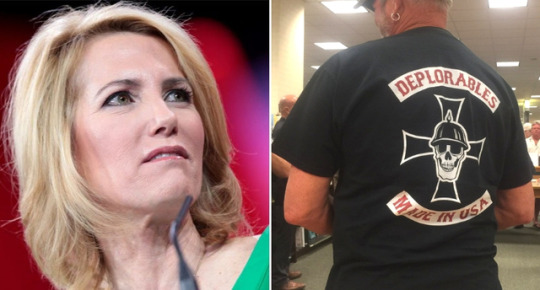
Fox News' Laura Ingraham posted photo of a Trump supporter wearing Nazi symbols.
The conservative host posted a photo of a man in a "Deplorables" shirt that features the Nazi "Iron Cross" and "Das German" skull in an unearthed tweet from 2017.
Published at Raw Story on March 6, 2019.
Fox News' Laura Ingraham posted a photo of a man in a "Deplorables" shirt that features the Nazi "Iron Cross" and "Das German" skull in an unearthed tweet from 2017.
Ingraham's post appears to have been taken at a book signing event at a Barnes & Noble store in Myrtle Beach, South Carolina on October 13, 2017.
"Thanks, Myrtle Beach!" the Fox News host wrote in the post, which was still online as of press time.
The photo features a man wearing a shirt that reads "Deplorables" — a reference to Hillary Clinton's infamous comment about Trump supporters being a "basket of deplorables" — and "Made in the USA."
Between the otherwise-innocuous slogans, however, are an Iron Cross and a skull wearing a spiked helmet — both lesser-known Nazi symbols.
As the Anti-Defamation League explains, the Iron Cross was once used as a Nazi military medal and often had a swastika superimposed on top of it. After World War II, neo-Nazis and white supremacists began using it without the swastika — though it remains an identifying symbol to hate groups and those in the know.
Lesser-known even than the Iron Cross is the skull seen on the man's "Deplorables" shirt.
The spiked helmet, known as the Pickelhaube, was a staple of German military headgear that appears to have made its way into Nazi symbolism — likely via a symbiosis of the helmet and the Nazi skull and crossbones symbol called the Totenkopf (German for "death's hand").
Raw Story has reached out to Fox News and Ingraham for comment about the post.
0 notes
Photo

Here are all the people who were convicted of treason in the US — and the ones who were executed for it
Published by Raw Story on July 17, 2018.
Photo features John Brown, the American abolitionist who led a failed slave rebellion on Harpers Ferry. Image via Wikimedia Commons.
In the aftermath of Donald Trump's unprecedented and alarming joint press conference with Russian President Vladimir Putin, critics have accused the American president of committing treason for his acquiescence to the Kremlin.
"Treason against the United States shall consist only in levying war against them, or in adhering to their enemies, giving them aid and comfort," Article III, Section 110 of the United States Constitution reads. "No person shall be convicted of treason unless on the testimony of two witnesses to the same overt act, or on confession in open Court. The Congress shall have power to declare the punishment of treason."
As the Washington Post noted in February 2017, "enemies are defined very precisely under American treason law."
"An enemy is a nation or an organization with which the United States is in a declared or open war," the 2017 report noted. "Nations with whom we are formally at peace, such as Russia, are not enemies."
In 2001, when a young man named John Walker became a "freedom fighter" for the Taliban and speculation about potential treason charges were floated, the San Francisco Gate noted in a report that throughout United States history "treason charges have been brought fewer than 30 times," and treason charges haven't been formally brought against any American since the end of World War II.
1. John Mitchell and Philip Vigol
As the University of Central Florida's David Lewis noted in his 2013 paper, "Breach of Allegiance: The History of Treason Charges in the U.S., and its Rebirth in the Age of Terrorism," John Mitchell and Philip Vigol (sometimes spelled Wigle) were convicted of treason and sentenced to hanging after the Whiskey Rebellion, a protest against the so-called "whiskey tax" meant to help recoup Revolutionary War debt during George Washington's presidency. They were pardoned by Washington before their executions.
2. John Brown
Known for leading an eponymous slave rebellion, abolitionist John Brown is likely the most famous American executed for treason in US history. Lewis noted in "Breach of Allegiance" that Brown was tried not by the federal government, but by the Commonwealth of Virginia. He led a raid on the West Virginia town of Harpers Ferry (then still a part of Virginia) on October 16, 1859. Intent on radicalizing the slaves there, Brown's uprising did not turn out as intended — the enslaved people did not take up arms, the white townspeople fought back against him, and he and his fellow raiders were captured by Confederate General Robert E. Lee. He was executed by hanging on December 2, 1859, and was memorialized as "a traitor in the south, and a patriot in the north," Lewis noted.
A unique addendum to the John Brown Rebellion was that a former slave named Shields Green was indicted for treason along with Brown's other co-conspirators, but was found not guilty because he was not considered an American citizen. The paper noted that although he was spared the treason conviction, Green was still hanged for his role in the failed rebellion shortly after Brown.
3. William Mumford
During the Civil War, Lewis' paper noted, a professional gambler named William Mumford who lived in New Orleans was the only person formally convicted of treason. Mumford, angered by the replacement of the Confederate flag with an American one at the city's US Mint building following the Navy's capture of the state, scaled a flagpole and removed the flag.
"For this action, he was tried by military tribunal on the grounds of treason," the paper noted. "His overt act was found to be the desecration of the American flag, and since the United States contended the southern states were still a part of the Union, Mumford was a U.S. citizen who owed allegiance to the country."
Mumford was executed by hanging on June 7, 1862 from the same scaffolding at the Mint building where he'd torn down the flag.
4. Mary Elizabeth Jenkins Surratt
Mary Elizabeth Jenkins Surratt was both the first woman executed in the United States and the first convicted of treason for her role in the aiding and abetting of John Wilkes Booth, the man who assassinated Abraham Lincoln. She was executed by hanging along with three co-conspirators in the District of Columbia on July 7, 1865.
5. Max Hans and Erna Haupt
German-born Chicago residents Max and Erna Haupt were convicted of treason after sheltering their son, the Nazi spy Herbert Haupt, who returned to the US after becoming a saboteur. Max admitted that he knew his son was working for the Nazis when he agreed to let him return to the family's home, and although his son was executed via electrocution for the crime, it was his parents who were convicted of treason.
"Breach of Allegiance" noted that although the Haupts appealed their treason convictions up to the Supreme Court, neither were successful, resulting in both of them being deported back to Germany.
6. Martin Monti
Martin Monti, a former American Air Force flight officer who defected to Italy and surrendered to Nazi German forces "shortly after the invasion of France by Allied Forces" in 1944. He then became an Axis propaganda broadcaster, and as Lewis noted, he "even wrote flyers that were given to Allied [prisoners of war]." He was found in Italy after the Axis surrendered, and after being approached by the FBI, he was found guilty of treason for defecting to the Axis and stealing an Air Force plane. He was sentenced to 25 years in prison.
7. Anthony Cramer
Born in Germany before becoming a naturalized American citizen, Anthony Cramer was found guilty of treason after hiding money provided by the Third Reich for Nazi spies Edward Kerling and Werner Thiel. Cramer's case became a landmark in treason law, however, when the Supreme Court overturned his treason conviction in the interest of preserving the restrictive nature of the definition of treason.
"According to the Supreme Court, in order to convict Cramer, the courts would have to ignore the rules established by the treason clause," Lewis wrote. "While Cramer had associated with enemies of the United States, he did not provide them with aid and comfort in any capacity, as is required by the treason clause."
8. Axis propagandists
During World War II, a number of Americans were tried in absentia and convicted of being propagandists for Axis powers. As Lewis noted, "Robert Best, Edward Delaney, Ezra Pound, Jane Anderson, Fred Kaltenbach, Constance Drexel, Douglas Chandler, and Max Otto Koischwitz were all indicted, in absentia, for treason against the United States in June 1943." Of those eight, only South Carolina-born Nazi propagandist Robert Best was ever convicted, and he served a life term until his death in 1952.
Two other women — Mildred Gillars and Iva D’Aquino — were also convicted of treason, and their cases serve as a reminder of the creative legal maneuvers used by postwar prosecutors to attain convictions.
Known as "Axis Sally" and "Tokyo Rose" respectively to deployed GIs during the war, Gillars and D'Aquino worked as broadcasters during the war in Germany and Japan. Gillars was found to have committed treason after her prosecution established that she'd taken a written oath of allegiance to the Nazis; the Japanese-American D'Aquino, however, was stranded in Japan after the attack on Pearl Harbor and despite working for a radio station, she refused to broadcast anti-American sentiments.
"Nevertheless, D’Aquino was arrested and indicted in 1948 for eight counts of treason, and the jury convicted her on only one of those counts," Lewis wrote. "The prosecution argued she provided aid and comfort to an enemy nation, and two key witnesses, George Mitsushio and Kenkichi Oki, testified at trial against D’Aquino."
D'Aquino's conviction was upheld on appeal and she served six years in prison for treason. In 1976, she was pardoned by President Gerald Ford after investigators revealed that Mitsushio and Oki perjured themselves and were coerced to lie under oath by the FBI, "Breach of Allegiance" noted.
9. Tomoya Kawakita — the last American convicted of treason against the US
After being stranded in Japan during the war, dual Japanese-American citizen Tomoya Kawakita became an interpreter for a POW camp. While working in the camp, Kawakita was said to have treated POWs cruelly "and would devise despicable methods of tormenting them," Lewis noted.
He returned to the United States after the war and claimed when reapplying for a US passport that he'd only renounced his American citizenship under duress. A POW recognized him and Kawakita was subsequently arrested, and during his trial his lawyers argued that he was not an American citizen during the war because he'd lost that status when he confirmed his Japanese birth.
"Breach of Allegiance" noted that Kawakita was convicted of eight out of the 15 counts of treason he was indicted on and sentenced to death — a sentence commuted by President Dwight Eisenhower in 1953, who insisted he spend life in prison. President John F. Kennedy pardoned Kawakita on the condition he be banished from the United States.
#treason#raw story#trump#john brown#harpers ferry#treason convictions#tomoya kawakita#axis sally#tokyo rose#trump treason
1 note
·
View note
Photo

What Seeing Big Women In The Olympics Means To Me
Initially published by Bustle in August 2016 and later picked up by HuffPost.
My Olympics fandom is, unfortunately, marred by a nagging thought, present through all the coverage I watch: none of these people have bodies that even remotely resemble the wide-hipped, soft tummied flesh vessel I call home. At least, not until recently. That’s why Sarah Robles’ weightlifting win is a big deal for big girls like me: we finally have an Olympic medalist whose body looks more like our own.
I, like millions of other people, have been obsessively following the goings-on of the 2016 Rio Olympics. Every few years, a mini-Hollywood for the athletically-talented springs up somewhere cool, and for two weeks, we peasants get to watch their feats of strength and grace, all while looking down at ourselves and murmuring “there’s no way I could do that!” My Olympics fandom is, unfortunately, marred by a nagging thought, present through all the coverage I watch: none of these people have bodies that even remotely resemble the wide-hipped, soft tummied flesh vessel I call home. At least, not until recently. That’s why Sarah Robles’ weightlifting win is a big deal for big girls like me: we finally have an Olympic medalist whose body looks more like our own.
Between Robles and American shot put gold medalist Michelle Carter, the 2016 Olympics have offered two incredible role models for body diversity in a worldwide-televised event that typically showcases the built and svelte, but not the curvy. To have two larger women win Olympic medals for their strength, athleticism and skill doesn’t just offer visual representation for plus size women: it diverges from dominant roles for fat women in media, which typically casts big women as the fat, funny sidekick or the “sassy black woman.” Both of these tropes are offensive and show fat women as one-sided stereotypes rather than, you know, nuanced individuals with as many dreams and experiences as thinner people.
Despite the significant fat-positive progress made in entertainment (and even in the health industry, which has long been considered at-odds with the fat positivity movement), it’s telling that there are still so few plus-size role models in athletics, a field most consider to be in opposition to fat acceptance. The response to the concept of being plus size and healthy is so extreme that the supermodel Ashley Graham, who graced the cover of the Sports Illustrated’s annual swimsuit edition earlier this year, was the subject of fat-phobic vitriol online at a mere size 16, only one dress size above the average American woman and what fat activists consider “small fat” or at the smaller (and more socially acceptable) end of the plus size spectrum.
Seeing Carter and Robles in the news showing off not only their bodies but, more importantly, their strength, was something of a revelation for me — and I’ve been involved in fat and body positivity for eight years. Our culture has reached a point where we can accept big women and people can be as beautiful and desirable and stylish (and smart, and healthy) as anyone else, but we’re only now making inroads into the concept that fat people and fat women specifically can also be strong and athletic as well.
There’s a reason why people from marginalized, oppressed, and otherwise un-represented groups crave representation in society. Big girls like me grow up with so many implicit and explicit messages telling us our bodies are wrong, whether it’s from the pages of the magazines we long to write for or the television shows and movies we aim to emulate. To see people that look like us, even if they’re airbrushed (or elite athletes) begins to remove, in our minds, a barrier that seems insurmountable without those representations. Of course a few big female Olympians aren’t going to suddenly make fatphobia and body shaming go away, but they add nuance to the body positive discussion that is increasingly co-opted to sell us crap we don’t want, often while feeding us the same harmful lines of thought we were raised on.
Seeing big women winning Olympic gold medals and being praised for their incredible athletic prowess in the world’s most exclusive arena tells us that not only are we able to wear the clothes we want or date the people we want, but we’re also worthy of praise and admiration because of what our bodies can do, and not in spite of them. The growing trend of diversity at the Olympics, be it racial or body type, shows that on at least one world stage, those of us who are marginalized needn’t apologize for who we are.
#editorial#sarah robles#olympics 2016#rio olympics#plus size#body positivity#noor al-sibai#plus size athletes#olympics#summer olympics#weightlifting
0 notes
Photo
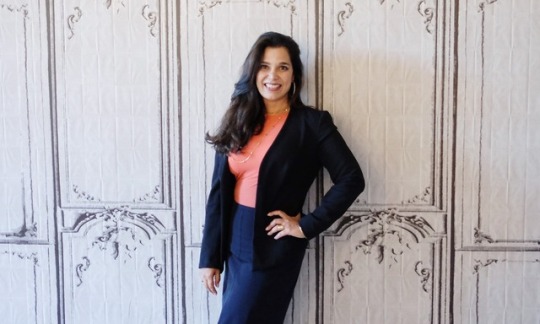
Kamala Lopez's Mission To Get Women Written In The Constitution Is More Important Than Ever
Published by Bustle, November 2, 2016
In an election year marred by gendered conflict, a holistic look at the state of women in areas outside the realm of politics is as necessary as it is refreshing. Kamala Lopez was fed up with the mistreatment of women in almost every facet of life, and decided to do something about it in the best way she knew how: through film. What she didn't bank on, however, was the difficulty of her journey — a journey that mirrors that of many women in this most pivotal and depressing of election years.
Lopez makes the personal political in Equal Means Equal, her Kickstarter-funded documentary about the manifold ways women are discriminated against in the U.S. It couldn't have come at a better time.
Lopez was candid when speaking with Bustle about just how hard it was to see her passion project to completion. "It's really been a very, very long and arduous journey," Lopez says "The Kickstarter was really about the halfway point because we started filming and trying to put this thing together back in 2009."
Between 2009 and 2013, Lopez and her crew traveled across the country filming for their documentary, trying to get women on the record to discuss their experiences with discrimination. In October 2013, the Equal Means Equal team started their crowdfunding campaign, and by the end of the month, they raised a whopping $138,000, far above their initial ask of $87,000.
During the long road from idea to finished product, Lopez said she witnessed and experienced multiple profound and intense moments. One of the most jarring occurred when she and her crew were interviewing artist Isabela Diaz, a personal friend Lopez had known for years, at their studio in Los Angeles.
Diaz, who has close ties to mothers and activists looking for their missing daughters in Juarez, Mexico (a city known for its alarming rates of female homicides), told the Equal Means Equal crew something they (Diaz uses gender neutral pronouns) had never told anyone else: that as a child, they were raped and left to walk home, bloodied and partially unclothed. Diaz walked through the crowded streets of their hometown in this condition, and nobody stopped to help them.
While Diaz was telling their story, one of the film's top crew members ran out the room crying. Lopez later learned that the crew member's mother was murdered in an incident of domestic violence on the crew member's wedding night, and Diaz's story brought up difficult memories about this deep family tragedy. That day, Lopez learned the painful secrets of two people close to her, and caught one of their stories on camera.
"Almost every woman in this country has experienced these things, and no one is untouched by them," Lopez says. "That's what was so intense about making this movie." And she's right — the Rape, Abuse and Incest National Network (RAINN) reported that one out of every six women are victims of rape or sexual assault, and that on average, someone is sexually assaulted every two minutes.
While the nature of anecdotes like these have the possibility of shocking viewers and inspiring emotion, Lopez says she believes emotional reactions can be a positive force of change. "People always make fun of others for being emotional," Lopez says. "I think we need to be more emotional so we can connect more with people. If we really put ourselves in the shoes of these women and these people, it would be really hard to continue to accept [the current state of women] and it would really change things."
Does Equal Really Mean Equal?
According to Lopez, the success of the Equal Means Equal is the result of a string of decidedly unsuccessful studio pitches. In a twist reminiscent of "Lewis's Law", which states that the comments on any feminist article prove the need for feminism, when Lopez pitched her project to studios, she claims she was often met with one shockingly sexist response: that it was somehow inappropriate for her to be shown in the documentary itself. This seemed to prove the need for Equal Means Equal given the blatant double standard that many male documentarians and filmmakers star in their own films.
"Many people told me that I had to take myself out of the movie, that the movie would not be able to get distribution and that nobody would see it because I was in it," Lopez says. "Then I thought, 'wait a minute — the highest-grossing American documentarian ever is Michael Moore, and he's in all his films. Morgan Spurlock is in all his films, Werner Herzog is in all his films, but I can't be in my film?'"
The creation of Equal Means Equal was uniquely emotional for Lopez, both because it was her passion project and because she often interviewed people like Diaz who'd experienced incredibly difficult circumstances, all of which moved her. The emotional nature of the documentary made the story Equal Means Equal tells a part of Lopez's story, too, and the thought of taking herself out of it completely felt wrong to Lopez, her co-creators and her family.
With a sigh, Lopez said that many of the studio executives who passed on the documentary because she was in it are women. Given the absurd levels of sexism taking place the highest levels of politics, Lopez's revelation is unfortunately unsurprising.
Lopez's experiences as a professional actress in films such as I Heart Huckabees and Born in East L.A. while also living as a woman of color haven't been a walk in the park: when she attended Yale, she said she felt like "a zoo animal" and that she felt as if she were treated differently from her majority-white peers for her "otherness." Her experiences in Hollywood weren't much better, and mirror her interest in the wage gaps between men and women, and particularly between white men and women of color.
"For women of color, it's such a different conversation," Lopez claims. "We're stuck at minimum wage scale pay forever. My quote as an actor actually went down over the years as I aged."
Age, Hollywood's most intrinsic taboo, offered Lopez something she didn't have when she was younger: a feeling of comfort not only in her own skin, but in any situation she finds herself in. The feeling of being an animal in a zoo is long gone — where she once felt uncomfortable entering rooms full of unknown or important people, Lopez says now she can command a room, and feels in her element everywhere she goes. Even in a youth-obsessed culture like ours, the professional experience of a woman with a long resume shouldn't be devalued, even though it often seems that a large swath of Americans would prefer to see that happen.
With Equal Means Equal running its victory laps, Lopez, like the rest of the country in this polarizing political climate, is looking toward the future — both for her film, and for herself. Her biggest dream for her film? To have it spark the change that finally sees women protected under the constitution within five years.
"I would love to see Equal Means Equal spread across the country in an organic, grassroots manner like wildfire and reignite the national conversations on full legal equality for women," Lopez says. "I'd like to see the youth pick up the mantle of their mothers and grandmothers and finish this once and for all so that our basic human and civil rights are not subject to political cycles, until we are in the constitution."
Lopez focused her lens in Equal Means Equal on the multifaceted inequalities women experience. Whether she's leading her audience through horrific stories of rape and sexual abuse, discussing the terrible confines of prostitution, or outlining the staggering wage gaps that women still face, Lopez manages to strike both a serious and comfortable tone that is likely to bring into the fold some who may have been put off by other documentaries of this ilk.
As the country that spawned Equal Means Equal threatens to reach a breaking point, Lopez has found her stride in her personal and political lives, and hopefully, we as a nation will find ourselves in a position where dreams like Lopez's can come true.
#editorial#kamala lopez#US constitution#women's rights#wage gap#women in the constitution#equal pay#equality#equal means equal#juarez
0 notes
Photo

4 Ways Mainstream Feminism Fails Muslim Women
Published by Everyday Feminism, January 2015.
One glaring division still exists in modern feminisms despite calls for intersectionality: the traditional divisions of the “Western” and “Eastern” worlds. And this division is exacerbated by the Western response to the “plight” of Muslim women.
Feminism can be broadly defined as advocacy for the sociopolitical rights and enfranchisement of women and full gender equality.
“Feminism,” however, is not one unified movement.
There are sex-positive feminists who argue against the “sex-negative” politics of Andrea Dworkin and her ilk in the early 90s, queer feminists who focus more on LGBTQIA+ issues, and Black feminists whose activism centers on Black women and women of color.
Here is where the term “intersectionality” a focus on the intersecting oppressions and privileges associated with race, gender, sexuality, disability, class, nationality, and so on comes into play.
And what we’ve got is a new generation emerging, emboldened and empowered by feminist, anti-racist, and queer blogospheres, that aims to be intersectional in their beliefs and approaches to social justice.
And yet, one glaring division still exists in modern feminisms despite calls for intersectionality: the traditional divisions of the “Western” and “Eastern” worlds. And this division is exacerbated by the Western response to the “plight” of Muslim women.
While outliers do exist, many Western feminists still view Islam and feminism as exclusive categories that are at odds. From support of or indifference towards FEMEN’s Islamphobic “activism,” championing Malala Yousafzai for standing up to the Taliban while ignoring the Western influence on poverty and violence in Pakistan, or spreading around of this NSFW photo of Egyptian activist Aliaa Elmahdy, Western feminists are adept at missing the point when it comes to women in Islam.
And that point is that yes, Muslim women face unique challenges, specifically in Muslim regions, but that criticizing Islam is an inadequate way to fight patriarchy and, moreover, disrupts solidarity with Muslim women.
Western feminists fail Muslim women on a number of fronts.
Here are four important examples and ways these injustices can be avoided.
1. Feeding into the White Savior Complex and Ignoring the Impact of Western Colonialism
Although the “white savior” has been a trope played out in entertainment and international policy for hundreds of years, writer Teju Cole reimagined the term in a 2012 article titled “The White-Savior Industrial Complex” where Cole discusses the inherent racism in the then-popular KONY 2012 and Invisible Children movements and the politics behind them.
The “white savior complex” posits the West (the “white man” a la Kipling’s infamous poem “The White Man’s Burden”) as the hero who “saves” the Eastern or African world, be it Ugandans under the regime of Joseph Kony or Muslim women oppressed by “sharia law” in places like Saudi Arabia and Pakistan.
It takes little explanation to reveal this worldview as blatantly racist and xenophobic, yet it persists in American and European liberalism and, more disturbingly, among Western feminists who aim to expose the oppression of Muslim women and “help” them.
Western feminists often point to the evils imposed upon women in other, less economically developed parts of the world in their justifications for their beliefs. From female genital mutilation to honor killings to the #BringBackOurGirls hashtag, these issues continue to play a large part in Western feminist rhetoric.
While those examples (and the countless other horrors visited upon women around the world used to justify Western intervention and inspire sympathy) are quite obviously terrible, they fail to recognize the significant political nuances surrounding the conversations.
They fail to notice that many of the regions where these practices occur are victims of Western imperialism and that many groups that carry them out, like Boko Haram and the Taliban, are direct results of colonialist regimes.
As explained by Emile Schepers, author of an article about the colonial roots of Boko Haram(the Nigerian extremist group that kidnapped nearly 300 girls from a boarding school earlier this year that inspired the #BringBackOurGirls social media movement), the public outcry and ensuing movement in the West treats the symptoms while ignoring the cause — in this case, British colonialism — of the issue.
2. Ignoring the Long and Vibrant History of Muslim Feminism
To a lot of Western feminists, Islam and feminism seem to be mutually exclusive categories.
Stereotypes about the nearly one billion Muslims worldwide abound, casting their female half (roughly 1/16 of the world’s population) as monolithically oppressed.
From Somalia to Yemen and the US to Morocco, from Australian muslimahs to French niqabis to Muslim women in India, the oppression remains constant. These women, by and large, are portrayed as voiceless victims of their patriarchal religion.
Not only are these Islamophobic portrayals dangerous and erroneous, but they also completely fail to take into account the rich and oft-overlooked histories of both Islamic feministmovements and feminist movements within Muslim-dominated countries.
Muslim feminisms, feminist movements in Muslim regions, and Muslim feminists in the West are as diverse and contradictory as their mainstream, white counterparts.
From Red Lips High Heels (a Lebanese blog) to MuslimGirl (the Seventeen magazine of Muslimahs) and many, many others, Muslim feminisms are experiencing an online renaissance alongside their non-Muslim counterparts.
Paired with the historical gains of Islamic feminisms — from the Daughters of Hajar’s “Islamic Bill of Rights for Women in Mosques” to the Turkish feminisms from the Ottoman period onward — Islamic feminists have been making waves in their ancestral homelands and beyond.
Add to that the feminisms of converts and a collage as multi-faceted and brilliant as traditional mosaics that adorn the world’s great mosques emerges — a diversity that Western feminists should not only heed when discussing women in Islam, but could also use as a learning tool in their own feminisms.
3. Creating a ‘Straw Muslimah’ and Serving Western Hegemony
The same stereotypes that lead to the incorrect narrative of the victimized Muslimah also serve a greater purpose: to stigmatize Islam as a whole and create a scapegoat for continued Western domination over Muslim regions.
The “Staw Muslimah,” a pious, submissive child-bearer does not exist in a vacuum. She is described as the victim of her husband, her father, or both. She is forced to wear hijab either by law in Muslim majority countries or by her oppressive husband and/or community. She longs for the freedoms of Western women and if she knows how to read, she is often not allowed literature other than the Quran. She is the poster child of Western interventionism.
And if “we” don’t save her, she will either have a miserable, painful life of violence or die in an honor killing.
There is no shortage of problems with this racist trope, spouted explicitly during the initial stages of the US invasion of Afghanistan and even by the Feminist Majority Foundation’s “Campaign for Afghan Women and Girls.”
The agreement between two seemingly contradictory interests — women’s rights and American militarism — is more than coincidental, and it has everything to do with protecting Western power by “spreading democracy,” a thinly veiled term used to justify wars in the Middle East for nearly 15 years.
Dubbed “imperialist” or “colonialist feminism,” this brand of interventionism aims to justify Western wars under the guise of human rights.
As Deepa Kumar, a Rutgers associate professor of Media Studies wrote recently, imperialist feminism is rooted “on the construction of a barbaric, misogynistic ‘Muslim world’ that must be civilized by a liberal, enlightened West.”
The motives behind “Save the Women” campaigns from Afghanistan to Nigeria are as muddy as they are impassioned: Is it well-intentioned interest in standing in solidarity with women or Western power play being proposed?
4. Ignoring the Actual Wants and Needs of Muslim Women
Despite concern for the lives and rights of Muslim women, Western feminists rarely consult actual Muslimahs about what they want or need — or if they even want their “help” to begin with.
Be those women self-identified feminists or not, their demands are often overlooked in favor of pedantic campaigns and legislation.
What do Muslim women want? Their demands are not so far-removed from those of their non-Muslim counterparts, though with a specifically religious bent.
They want (and are willing to fund) seemingly superfluous products (like lube and nail polish) in halal variations; they want to fight back against street harassment and gain political enfranchisement in Muslim majority countries and in the West. And, perhaps most tellingly, they want Westerners to stop viewing them as oppressed, particularly those who choose to cover.
In Who Speaks For Islam?, a book published by Gallup based on findings from worldwide polling of Muslims, the majority of women in both progressive Egypt and repressed Saudi Arabia believe that women should be able to vote free of influence from their families and should hold any job they are qualified for, including top positions of power. They not only want education, but are increasingly educated at the postsecondary level.
Muslim women want what women around the world want: to be protected under the law, to have access to education, to have reasonable expectations of safety.
The one noticeable exception is that Muslim women in the West specifically want the right to practice their religion however they see fit — a right infringed upon in France.
Despite an incredible amount of evidence to the contrary, Western feminists continue to “promote women’s rights” in a narrow and often bigoted manner.
Muslim women don’t need saving. They need enfranchisement within feminism.
By continuing the patronizing (and patriarchal) rhetoric and actions of imperialist feminism, Western feminists continue the spread of Western hegemony and hurt Muslim women in the process.
By taking the time to learn about Islam, about the traditional treatment of women based on Muhammad’s teachings and continued fights for women’s rights by Muslim women themselves, Western feminists can not only avoid the perpetuation of injustices they take part in, but can learn to be better allies to other disenfranchised people in the process.
0 notes
Photo
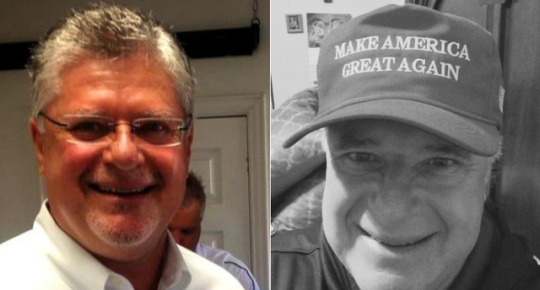
Texas Attorney General’s top aide mocks ‘pathetic’ #MeToo movement and uses misogynist slur for women’s marchers
Published by Raw Story on December 14, 2017.
One of Texas’ top lawyers appeared to take issue with the massive outpouring of sexual assault and harassment claims associated with the #MeToo movement in an early morning Facebook post on Wednesday.
As Dallas News reports, Associate Deputy Attorney General Andrew D. Leonie posted on Facebook at 2:40 AM on Wednesday decrying the women who’ve come forward with their stories as “pathetic.”
“Aren’t you also tired of all the pathetic ‘me too’ victim claims?” Leonie wrote. “If every woman is a ‘victim’, so is every man. If everyone is a victim, no one is. Victim means nothing anymore.”
In the post, which was still posted publicly on Leonie’s Facebook as of Thursday afternoon, the deputy assistant AG linked to an article from the conservative magazine The Federalist about how women “relish” male desire.
A perusal of Leonie’s Facebook timeline reveals him to be a staunch supporter of President Donald Trump’s. He also appears to be a fan of alt-right provocateur and erstwhile Breitbart writer Milo Yiannopoulos.
In a Twitter post made shortly after Trump’s inauguration and the historic Women’s March that followed, Leonie shared a cartoon that showed characters from the classic “Peanut” series, one of whom was dressed up in the genital costumes popular at the march. In Leonie’s cartoon, another of the characters calls the one in the costume a “c*nt.”
UPDATE: On Thursday afternoon, Texas Attorney General Ken Paxton’s office confirmed that Leonie resigned from his post as associate deputy AG. In a statement, the AG’s office said Leonie’s posts “do not reflect our values.”
#texas#texas attorney general#andrew d. leonie#ken paxton#AG ken paxton#raw story#noor al-sibai#investigative
0 notes
Photo
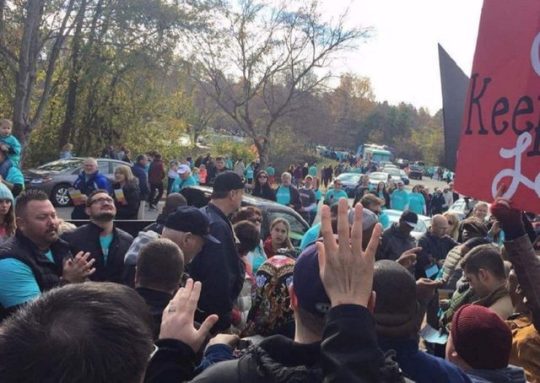
In Charlotte, Clinic Protesters Bring Diverse Tactical Playbook
Published by Rewire on August 16, 2017.
It's more high-tech than holding signs and yelling. Opponents disrupt phone service, install wi-fi networks designed to confuse patients, and offer ultrasounds in RVs outside at least one clinic.
Charlotte, North Carolina’s largest city, is at the center of a vicious battle between reproductive rights advocates and incredibly organized anti-abortion groups that launch regular massive clinic protests.
Such protests are far from new. Common tactics include standing outside (and often yelling at) clinics to threatening and sometimes attacking abortion providers.
But protesters at Charlotte’s clinics have begun adopting unorthodox tactics that includes the use of deafeningly loud sound and manipulation of online resources and search engine results.
Calla Hales, the administrator and co-owner of A Preferred Women’s Health Center (APWHC), which is the epicenter of the city’s current anti-abortion protest crisis, estimates that clinic staff began seeing an increase in protesters and a diversity of tactics in June 2016; that surge reflects 2016 National Abortion Federation statistics that reported more than 61,000 instances of picketing nationwide, the highest tally since the group began tracking anti-abortion violence and disruptions in 1977. Since last summer, the clinic has been a target for the ire of hundreds and at times thousands of protesters who block not only patients’ access, but also the neighboring health-care facilities in the business park where the clinic is located.
“There’s always been a protester presence here since this clinic opened in 2000, but it’s never been this hostile,” Hales said. “They’re in the street, they’re stopping cars, they’re saying hostile and inappropriate things on the loudspeakers.” It’s not clear why clinic protests ramped up, but the virulently anti-abortion group Operation Save America, which recently staged massive protests at Kentucky’s sole remaining abortion clinic, is headquartered in the Charlotte suburb of Concord. As a “descendant” of the radical anti-choice group Operation Rescue, the group has a decades-long history of anti-abortion mobilization, particularly blocking clinics.
The car-stopping and road-blocking constitutes a major facet of the issues at A Preferred Women’s Health Center, but it’s not the only one.
The protesters bring with them large RVs advertising ultrasounds (which are required for abortions in North Carolina, but are done within the clinic prior to the procedure) and noise amplifiers like that allow them to preach to clinic staff, patients, and clinic escorts and defenders.
What’s more, Hales says that officers with the Charlotte-Mecklenburg Police Department have been slow to respond to protester noise that exceeds acceptable levels stipulated by local ordinances. In the past year, she and her staff filed for thousands of sound permits to block protesters from utilizing speakers that would blare their anti-abortion messages. But the clinic has only been granted permits on less than ten occasions; clinic protesters received them the overwhelming majority of the time. The Charlotte-Mecklenburg Police Department could not be reached for comment about its handling of noise complaints. But the city recently changed the application process for sound permits, which could make the outcome more equitable.
Beyond concerns related to sound and the police, there are also issues with a wi-fi node for an open network named “Abortion Info.” Hales believes that one of the large RVs often parked outside the clinic is the home to the network.
Patients seeking internet access inside the clinic will often click the unsecured network, thinking it belongs to the clinic (which doesn’t have an open network due to security concerns). They are instead greeted by a log-in page whose design and logo resembles those of APWHC. To access the internet, people must watch a series of anti-abortion propaganda videos, and some who have logged onto the network reported to clinic staff that they later received calls, emails, and social media messages from people asking them if they need “guidance for abortion care.”
The cybersecurity concerns don’t end there. In March, the clinic’s network firewalls fell to “delay-of-service” attacks, where communications are slowed, often by flooding a system with thousands of false requests. These attacks increasingly target health-care facilities.
The delay-of-service attacks crashed APWHC’s phone and internet service and cost thousands of dollars in repairs. In an interview with the Charlotte Observer, the leader of Cities4Life, one of the main groups targeting the clinic, said that his group had nothing to do with the attacks and insinuated that Hales and clinic staff may have faked the attack for publicity. Since the March hack, Hales reported ten unsuccessful hacking attempts detected by their updated firewall.
Unfortunately, APWHC is not the only Charlotte abortion clinic that has fallen victim to cyberattacks from unidentified sources. According to clinic manager and counselor Sarah Shanks of Family Reproductive Health (FRH), someone not affiliated with the clinic changed its Google business page earlier this year. The attacker changed the listing’s phone number to the clinic’s fax number and changed the login information, so for nearly three weeks, the clinic says it could not reach or be reached by patients calling its regular phone number.
“It was devastating to just hear the fax number ring all day, knowing it was maybe our patients or other people trying to reach us,” FRH’s Shanks said in the hallway of the quiet clinic.
Like APWHC, FRH also experiences some sound-related disruptions. There are fewer protesters at FRH due to location; APWHC is in a high-traffic, accessible business park, and FRH is tucked away in a more industrial neighborhood behind a large wooden fence and a barbed-wire one around the staff parking lot. That solid 6-foot-tall fence, however, doesn’t stop protesters from standing over it with an even taller ladder and a loudspeaker.
Beyond the physical presence and noise the protesters bring, there are also other, more sinister concerns at play. In an incident last fall, an anti-abortion protester made sure APWHC clinic escorts saw he carried a holstered gun though he did not pull it out; North Carolina allows licensed people to carry concealed weapons, but not the brandishing of those weapons. He fled from clinic security when confronted, only to circle the block slowly in his vehicle and park across the street. When the clinic called the police, Hales said a police officer dropped by but did not stop to speak with the man still parked across the street. Nothing more came of the altercation. Though the clinic called 911, Hales said there was no official report filed because no officers came to speak following the incident.
At both clinics, the anti-abortion protester presence has forced clinic staff and volunteers to the defensive—a move they say isn’t always conducive to caring for their patients. At APWHC, it forces them to do more work to counter their opponents’ moves, and sometimes that means resorting to more old-fashioned tactics.
Volunteer Diana Travis’ work with clinic defense includes building baffles around anti-abortion protesters’ sound amplifiers and constructing a 100-foot privacy wall out of black tarp and reinforced PVC pipes every Saturday. She expressed optimism that with sustained pressure from advocates, they can effectively counter protesters.
“I am hopeful things will change, but it’s going to be a long haul and will need constant monitoring,” Travis said.
#noor al-sibai#charlotte#charlotte nc#abortion clinic#planned parenthood#abortion#anti-abortion#pro-choice#pro-choice NC#NARAL#NC#north carolina#investigative
0 notes
Photo
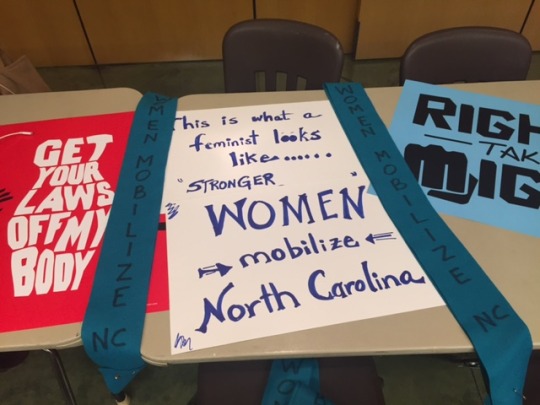
How Women In North Carolina Are Resisting HB2 & Donald Trump In The Same Breath
Published on Bustle Jan. 23
On Jan. 21, women and their allies in over 600 cities and towns across the country marched to show the massive political power of women in America and show solidarity with those who may need defending during Trump's presidency. In Raleigh, the capital of North Carolina, the issue at hand wasn't just the president, but also how to protest a legislature that seems to many to be bent on eliminating the rights of LGBT people, women, and working class people. The organizers of the Women's March on Raleigh took the time to explain to Bustle just how much is at stake for them and the countless women across N.C. whose rights they are fighting for.
On an unseasonably warm Tuesday evening, a few dozen women (and a handful of men) gathered in the basement of the most progressive Christian church in Raleigh to put the finishing touches on their Saturday march that would draw a crowd of more than 17,000 people. One woman informed the group that there would be more than 600 affiliated women's marches happening that day; another woman, who is transgender, told everyone that on Jan. 21, the day of the march, she'd be celebrating her 20th transition anniversary. There was a palpable sense of camaraderie among the group, and looking around, it was stunning to witness just how diverse the organizers of this event were.
In North Carolina, there is far more to organize for and against than just the incoming administration. In 2016, the state became globally infamous for its passage of HB2, the so-called "bathroom bill" that also eliminated the ability to sue for workplace discrimination and prohibited cities from setting their own minimum wages above the state-appointed $7.25-an-hour.
Later, the state's former governor Pat McCrory contested his loss to his challenger Roy Cooper, only to lose even more sorely in the recount. And the same Republican legislature that passed HB2 worked swiftly to reduce the power of the incoming Democratic governor in a shocking political event now commonly known as "the Carolina coup."
It was both the "Carolina coup" and HB2 that brought Salma Mirza, the march's communications co-chair and activist in the neighboring city of Durham, to the march. Mirza, who attended college at UNC Chapel Hill, says they moved to Durham just a few weeks before the passage of HB2. At that point, they knew it was time to fight.
"Sometimes when you're organizing, your emotions are just muted, and you just go from thing to thing, and you're like an automaton," Mirza says. "But HB2, the way that it passed so quickly, with the anti-queer provisions, the anti-worker provisions, anti-local governance stuff, was just so infuriating that I wanted to get involved in something."
Get involved they did. Following the March 2016 passage of HB2, Mirza and four other queer activists were arrested outside of the governor's mansion after refusing to leave the street on police orders. Now, despite feeling a sense of despair due to the election results, Mirza says she and fellow activists feel more motivated than ever.
"I just realized that there was too much to do, that I had to pull myself out of that despair and shock," Mirza says. "We have to come together in community and organize the kind of fight that we need to build the kind of community we need and have each others' backs, not just to be the ones resisting but to eventually build power."
"Community" was a term echoed throughout the meeting, and was especially important to Angela Bridgman, a trans woman and recent N.C. transplant whose driving factor to join the march was HB2. Bridgman, who mentioned that the march falls on her 20-year transition anniversary, says the backlash from the bill pales in comparison to the support she's received as a trans North Carolinian in her local community.
"In 20 years of being an out trans person, I have never seen the kind of support that we now have since HB2 passed," Bridgman says. "I looked around me, and I saw all this support, and the first question I had was 'where have you all been for 19 years when I was a one-woman army?' I'm very grateful for that support."
That support, however, came at a terrible cost. As a veteran of the LGBT community, Bridgman admits that HB2 still came as a heartbreaking shock. The need for community in the face of such seeming bigotry, both in the N.C. state legislature and from the office of our new president, helped inspire the regional women's marches.
But "women" are not a singular force (just ask the 53 percent of white women voters who voted for Trump). Even from its earliest stages, there has been worries of racial division and a lack of inclusivity at the Women's March on Washington and the hundreds of affiliate marches around the nation.
It was that worry that brought Saba Taj, a queer Muslim artist and activist based in Durham to the Women's March on Raleigh planning meetings.
"Folks were noticing a need for more people of color, so I was like 'yeah, let's see!', and that's how I got involved," Taj tells Bustle.
For Taj, HB2 was also an inextricable part of their drive to organize for the women's march. They hope to see conversations around the various intersections of reproductive rights, gender identity (especially in regards to trans women of color) and race ensue from the march.
"I think that's definitely something we're addressing in this march in particular, understanding that it’s trans women in particular who are most impacted by this legislation in terms of the bathroom part of it," Taj says.
The intersectionality and diversity present in that room of organizers was reassuring in the face of accusations of white woman-focused feminism that have surrounded the nationwide women's marches. Sarah Moncelle, a former statewide organizer with the Feminist Majority Foundation and one of the founding organizers of the Raleigh women's march, says the diversity was striking for her.
"We've had some incredible conversations when planning this march about understanding each other better, understanding our communities better, understanding that there are so many different voices, and meeting people that we wouldn't normally meet or interact with in our day-to-day lives," Moncelle said. "It's really beautiful."
Moncelle's background in politics helped her understand that the upsetting election of Trump would be an opportunity for people to organize like never before. She said that in the initial planning stages, women began coming forward who had no activism experience but who wanted to get together and make their voices heard.
"As frustrated as I am about N.C.'s legislature, the Carolina coup, and the Trump presidency, I’m encouraged knowing that I’m amidst all these incredible women," Moncelle tells Bustle. "They're coming together and saying 'I don't have experience but I know the stakes are higher and I wanna get out there and participate.' I think this is the start of something big, and we're excited."
There has been a fear among progressive North Carolinians that our state legislature's shocking mistreatment of its trans and working class citizens might foreshadow what's to come for the rest of the country. On Jan. 20, we were proven right when the newly sworn-in President Trump appointed John Gore, a lawyer who defended the state's university system's acquiescence to HB2, to a high-ranking civil rights position.
Whether or not they knew about Gore's appointment when they were marching, tens of thousands of people marched in N.C. in defiance of both the Trump administration and the N.C. legislature that has drawn such negative attention to this purple Southern state. If the organizing team behind the women's march in the state capital is any indication of the diverse, complex, and committed groups of activists working across the state and across the country, then Trump and the N.C. legislature can bring it on.
#hb2#women's march#women's march on raleigh#raleigh#raleigh nc#nc#north carolina#intersectionality#noor al-sibai#bustle
0 notes
Photo

Why Jewish Solidarity Means So Much To Me As A Muslim American
Published on Bustle Feb. 15
As an Arab-American raised in the liberal Unitarian church with a Muslim name and family, my experiences with Islamophobia have come from surprising places — not only from the ignorant classmates who joked about terrorists, but also from the staunch Israel supporters I met at my UU church. I can't remember the first time I realized that there existed a centuries-deep divide between Muslims and Jews, but it has followed me for my entire life. That's why the growing solidarity between Jews and Muslims since Donald Trump was elected president has been near-revolutionary for me.
The headlines about the potential for Muslim bans and registries that seemed so impossible during the election cycle suddenly became all too real on Nov. 9. In the Southern Poverty Law Center's report on bigoted harassment and vandalism post-election, they revealed that public discrimination and violence rose significantly after the election. Both Muslims and Jews (along with Black people, immigrants, and LGBT people) were targets, and the intimidation ranged from a college dorm that was vandalized with swastikas to letters advocating Muslim genocide received in mosque mailboxes across the country.
With the growing trend of "alt-right" anti-Semitism and the solidified Islamophobia of Trump's campaign rhetoric now seemingly enshrined by his election, fears of what would happen to us all dominated the Facebook chatter of both my Jewish and Muslim friends.
As fears of violence mounted after the election, so too did acts of solidarity. Shortly after the election, the Anti-Defamation League (a Jewish-led anti-bigotry organization) expressed their solidarity with American Muslims, and in Dec., the Boston chapter of Jewish Voice for Peace held a march against Islamophobia. These were particularly striking to me due to my personal experiences within the Arab-Israeli conflict, and with the tensions between Muslims and Jews that it created.
It's not an understatement to say that I began to fear for my my life and the lives of my family after Trump was elected. Unfortunately, that wasn't a new sensation — 10 years prior, we experienced war with Israel while vacationing in Lebanon in what came to be known as the "2006 Lebanon war." While resting in an apartment near the beach, Israeli forces dropped bombs on the nearby marina, starting a weeks-long escape. I spent years in therapy dealing with the trauma that resulted.
I soon discovered that tensions of the Arab-Israeli conflict also existed in Muslim and Jewish diasporas in the U.S. While I was still in Lebanon, my white mother (who was still in the States and is critical of Israel) and my Jewish best friend's dad (who held a very staunch pro-Israel stance) had a falling out over whether Israel was justified in bombing Lebanon despite the reality that it put my life at risk. Both were Democratic-voting, Unitarian Universalist liberals, and the divide between our families hasn't softened much in the decade since.
The tense and divisive nature of the Jewish-Muslim divide among liberals followed me into academia, where I was surprised to find non-Arab criticism of Israel for the first time in my life. Unfortunately, I soon noticed that many of my peers used criticism of Israel to hide their anti-Semitism, making the thought of healing the deep wounds between American Muslims and Jews seem all the more impossible. Beyond personal friendships I took part in and witnessed and the occasional headline about the difficulties of coalition-building, the dream of a joint Muslim-Jewish solidarity seemed like an idealistic fantasy.
In the weeks since Trump issued the immigration ban, however, I've not only seen headlines about Jewish-Muslim solidarity — I've also been the recipient of multiple personal messages of support from Jewish people I know and seen Jewish people express support for Muslims like never before. Headlines about amazing acts of mutual support began to flood my feed, from the synagogue that opened their doors to their Muslim neighbors in Texas after their mosque was burned down to historical articles about Muslims that sheltered Jews during the Holocaust proliferating on Holocaust Remembrance Day.
As our new president doubled down on his attacks against this demonized religious minority, members of the Jewish faith asserted all over the country that "never again," the pledge Jews took after the Holocaust, must apply to all. On Feb. 5, members of the "Kindertransport" group of Jewish children that were whisked away to safety just prior to the Holocaust issued an open letter to President Trump regarding his ban on Syrian refugees. The letter reminds Trump and all Americans of the rejection of Jewish refugees during World War II, and of the dark consequences that resulted.
As more and more legal and popular pressure against Trump's immigration ban mounts, the likelihood of this first massive hurdle in the resistance to Trump's presidency ending one way or another looms ever closer. Despite the reality of more battles to come, Jews continue fighting on behalf of Muslims. There was a Jewish rally for refugees on Sunday in New York, and more and more articles and public pledges of solidarity come out every day. The seeds of this seemingly spontaneous and intentional coalition between Jews and Muslims in the U.S. are now firmly planted, and this show of support means the most to me.
There is no doubt that there will be difficult conversations and examinations of the rift caused by the always-present Arab-Israeli conflict in joint Muslim-Jewish organizing. There are many, many coalitions that must be formed between groups targeted by Trump and his agenda, but for now, I take solace in this surprising and poignant outpouring of solidarity for me and mine from perhaps the only other group to truly understand the dangers that may lie ahead.
#arab-israeli conflict#muslims and jews#islam and judaism#solidarity#muslim-jewish solidarity#muslim voices#bustle#noor al-sibai
0 notes